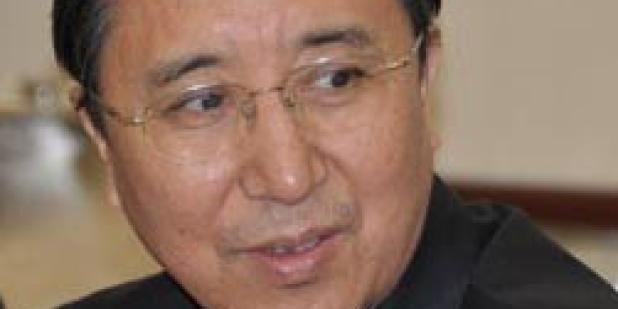Happy Lunar New Year from the USC US-China Institute!
PRC Officials Discuss Tibet Situation with USC Scholars and Students
Top government negotiator Sita leads delegation

For other articles and documents on Tibet, click here.
By PETER WINTER
 |
|
Dalai Lama, speaking in Australia, on June 11, 2007, image from Ferne Millen and used under Creative Commons license |
non-Tibetans were targeted and many were killed. A military crackdown ensued. Critics of China’s policies in Tibet used the Olympic torch relay stops in Europe and America to demonstrate, prompting counter-demonstrations in China. Beijing authorities blamed the unrest on the “Dalai clique” and said that many foreign critics were simply faking concern for Tibetans in order to bash China. For his part, the Dalai Lama insisted he was not seeking Tibetan independence and expressed support for the Beijing Olympics. He called for an end to violent protest and repression.
Vice Minister Sita (斯塔) was among the Chinese government representatives meeting with the Dalai Lama’s aides. A Tibetan who worked as a teacher and village official in the autonomous region, Sita eventually went to Beijing for college and was later recruited into central government service. He is 54 and has served in China’s embassy in India and a consulate in Switzerland. Sita opened his presentation affirming five points about Tibet. The first is the government’s position that Tibet is an inalienable part of China, noting that the country has exercised effective sovereignty over the region since the Yuan dynasty (the Mongol dynasty, 1279-1368). The Vice Minister’s second point is that as an Autonomous Region, Tibet already enjoys greater self-rule than ordinary provinces. Tibetans, he said, control critical decisions. Tibetans and other Chinese citizens, Sita said in making his third point, enjoy religious freedom. Religion, he insisted, is flourishing. Tibet currently has 1,787 active monasteries, with roughly 42,000 practicing monks. Sita stressed that there is by law, and in reality, a separation of religion and government. His fourth point was that Tibet has enjoyed great economic progress in recent years and that this will be accelerated thanks to government plans to invest US $22 billion in the region by 2010.
The Vice Minister’s final topic was the central government’s evolving relationship with the Dalai Lama. Sita argued that during the Qing dynasty (the Manchu dynasty,1644-1911), Beijing granted the Dalai Lama political leadership of the region. The current Dalai Lama is the 14th and is now 73. He was 15 when Chinese troops moved into Tibet in 1951. Sita insisted the Dalai Lama was a partner in ruling Tibet, but was unwilling to accept true reform following the 1949 revolution. He fled China in 1959 to establish his “so-called government and engage in separatist activities.”
 |
|
Lamu, chair of the Chinese Tibetan Political Consultative Conference for Nagqu Prefecture |
The discussion turned to economic conditions within Tibet when an audience member asked if the disparity between rich and poor had an ethnic component, which may help explain tensions there. Luorong Zhandui (罗绒战堆), a researcher with the Chinese Center for Tibetan Studies, said that while a large disparity in incomes does exist, it is not an ethnic issue but rather a divide between urban and rural populations. The disparity is large, Luorong conceded, with urbanites averaging 3.8 times the income of rural residents, but this gap has shrunk thanks to economic reforms and central government investments in the region. At the start of the decade, he said, the gap was still larger with rural residents averaging just one-fifth the income of urban dwellers. Luorang argued that because of its greater poverty and isolation, the central government has had to invest more in Tibet than elsewhere. In Tibet, the plan has been to develop the infrastructure of the regions major cities, and allow them to become development engines for the greater area. Luorong explained that most projects give hiring preference to Tibetan herdsmen and farmers. He said that sometimes these people lacked the education or work habits needed, but were still paid anyway. Lamu (拉姆), chair of the Chinese Tibetan Political Consultative Conference for Nagqu Prefecture and one of two women in the delegation, also highlighted the economic expansion the province has undergone since 1950. She noted that while 900,000 farmers lacked proper housing when the army arrived in 1951, virtually all now have spacious and adequate housing facilities.
Peter Winter is a USC graduate student in public diplomacy and is deputy managing editor of US-China Today.
Related documents:
Tibetan exile leadership, "Memorandum on Genuine Autonomy for the Tibetan People," Nov. 16, 2008
Chinese government response, "On the 'Memorandum' of the Dalai Clique," Nov. 21, 2008
Other articles and documents on Tibet:
Fifty Years of Democratic Reform in Tibet | Kolas, Tourism and Tibetan Culture in Transition: A Place Called Shangrila | PRC Officials Discuss Tibet Situation with USC Scholars and Students | Memorandum on Genuine Autonomy | Testimony on ‘The Crisis in Tibet: Finding a Path to Peace | Tibet: Problems, Prospects, and U.S. Policy | The Way to Resolve the Tibet Issue | President Obama Meets with the Dalai Lama | On the 'Memorandum' of the Dalai clique | Beijing-Based G-5 Chiefs of Mission on DPRK, GTMO, Uighurs, Sino-Japan Relations, Dalai Lama |
Featured Articles
We note the passing of many prominent individuals who played some role in U.S.-China affairs, whether in politics, economics or in helping people in one place understand the other.
Events
Ying Zhu looks at new developments for Chinese and global streaming services.
David Zweig examines China's talent recruitment efforts, particularly towards those scientists and engineers who left China for further study. U.S. universities, labs and companies have long brought in talent from China. Are such people still welcome?






